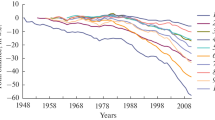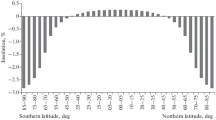Abstract
On the basis of calculations of insolation and insolation characteristics, taking into account changes in solar activity, the causes of global climatic events in the late Holocene have been determined. The main reasons for the Little Ice Age (LIA) are the long and deep minimum of summer insolation and insolation seasonality (IS) in the Northern Hemisphere. The values of the minimums are fixed in the range of approximately 1400–1750. The depth of the minimum over the past 5000 years, taking into account the change in solar activity, is about 8.0 W/m2 for summer insolation and about 13.3 W/m2 for IS in the Northern Hemisphere. The medieval climatic optimum is associated with the winter maximum of insolation contrast (IC) in the Northern Hemisphere, reflecting an increase in the meridional heat transfer in the winter half of the year from the equatorial region to the polar regions, as well as with a maximum of interhemispheric heat transfer. The increase in winter IC at maximum (1118) relative to 3000 BC is 28.4 W/m2. The difference between the hemispheric radiative heat transfer at the maximums (881, 940, and 976) increases by 5.0 W/m2 relative to 3000 BC. Thus, global events of the late Holocene are associated with extremes of insolation characteristics (incoming radiation, IC, and IS of the Earth), but the temporal structure of the extrema themselves is determined by variations in solar activity. It follows from the above that, when reconstructing and predicting global climatic events, it is important to take into account not only variations in the incoming radiation, but also the associated changes in insolation characteristics (IC and IS of the Earth), reflecting the mechanisms of heat transfer. The IC regulates the meridional transfer of radiation heat; its cause is a change in the tilt of the axis and precession. The IS of the Earth determines the intensity of interhemispheric heat transfer. The noted characteristics of insolation, reflecting not only variations in the arrival of solar radiation, but also variations in the mechanisms of heat transfer, are not taken into account in the general astronomical theory of climate. Taking these indicators into account will help obtain more complete information about climate changes in past eras and will allow the more accurate forecasting of the future climate.













Similar content being viewed by others
REFERENCES
Berger, A., Long-term variations of daily insolation and quaternary climatic changes, J. Atmos. Sci., 1978, vol. 35, no. 12, pp. 2362–2367.
Bertrand, C., Loutre, M.F., and Berger, A., High frequency variations of the Earth’s orbital parameters and climate change, Geophys. Res. Lett., 2002, vol. 29, no. 18, pp. 40-1–40-3. https://doi.org/10.1029/2002GL015622
Borisenkov, E.P. and Pasetskii, V.M., Tysyacheletnyaya letopis’ neobychainykh yavlenii prirody (Millennial Record of Extraordinary Natural Phenomena), Moscow: Mysl’, 1988.
Borisenkov, E.P., Tsvetkov, A.V. and Agaponov, S.V., On some characteristics of insolation changes in the past and the future, Clim. Change, 1983, no. 5, pp. 237–244.
Brouwer, D. and Van Woerkom, A.J.J., The secular variation of the orbital elements of the principal planets, Astron. Pap., 1950, vol. 13, pp. 81–107.
Büntgen, U. and Hellmann, L., The little ice age in scientific perspective: Cold spells and caveats, J. Interdiscip. Hist., 2014, vol. 44, no. 3, pp. 353–368. https://doi.org/10.1162/JINH_a_00575
Cionco, R.G. and Soon, W.W.-H., Short-term orbital forcing: A quasi-review and a reappraisal of realistic boundary conditions for climate modeling, Earth Sci. Rev., 2017, vol. 166, pp. 206–222.
Cionco, R.G., Valentini, J.E., Quaranta, N.E., and Soon, W.W.-H., Lunar fingerprints in the modulated incoming solar radiation: In situ insolation and latitudinal insolation gradients as two important interpretative metrics for paleoclimatic data records and theoretical climate modeling, New Astron., 2018, vol. 58, pp. 96–106.
Cionco, R.G., Soon, W.W.-H., and Quaranta, N.E., On the calculation of latitudinal insolation gradients throughout the Holocene, Adv. Space Res., 2020, vol. 66, pp. 720–742. https://doi.org/10.1016/j.asr.2020.04.030
Climatic Change, Gribbin, J., Ed., Cambridge Univ. Press, 1978; Leningrad: Gidrometeoizdat, 1980.
Davis, B.A.S. and Brewer, S., Orbital forcing and role of the latitudinal insolation/temperature gradient, Clim. Dyn., 2009, vol. 32, pp. 143–165.
Degroot, D., The Frigid Golden Age: Climate Change, The Little Ice Age, and the Dutch Republic, New York: Cambridge Univ. Press, 2018.
Fedorov, V.M., Interannual variations in the duration of the tropical year, Dokl. Earth Sci., 2013, vol. 451, no. 1, pp. 750–753. https://doi.org/10.1134/S1028334X13070015
Fedorov, V.M., The problem of meridional heat transport in the astronomical climate theory, Izv., Atmos. Ocean. Phys., 2019a, vol. 55, no. 10, pp. 1572–1583. https://doi.org/10.1134/S0001433819100025
Fedorov, V.M., Analysis of the components of a different physical nature in the interannual variability of the total solar irradiance flux, Sol. Syst. Res., 2019b, vol. 53, no. 5, pp. 376–382. https://doi.org/10.1134/S0038094619040026
Fedorov, V.M. and Frolov, D.M., Spatial and temporal variability of solar radiation arriving at the top of the atmosphere, Cosmic Res., 2019, vol. 57, no. 3, pp. 156–162. https://doi.org/10.1134/S0010952519030043
Fedorov, V.M. and Kostin, A.A., The calculation of the Earth’s insolation for the period 3000 BC–AD 2999, in Processes in GeoMedia (Ser. Springer Geology), Chaplina, T.O., Ed., Springer, 2020, vol. 1, pp. 181–192. https://doi.org/10.1007/978-3-030-38177-6_20.
Fedorov, V.M., Kostin, A.A., and Frolov, D.M., Influence of the shape of the Earth on the characteristics of the irradiation of the Earth, Izv., Atmos. Ocean. Phys., 2020, vol. 56, no. 10, pp. 1301–1313. https://doi.org/10.1134/S0001433820100035
Grove, J.M., The Little Ice Age, London–New York: Methuen, 1988.
Hodell, D.A., Brenner, M., Curtis, J.H., Medina-González, R., Ildefonso-Chan Can, E., Albornaz-Pat, A., and Guilderson, T.P., Climate change on the Yucatan Peninsula during the Little Ice Age, Quat. Res., 2005, vol. 63, no. 2, pp. 109–121.
Kopp, G. and Lean, J., A new lower value of total solar irradiance: Evidence and climate significance, Geophys. Res. Lett., 2011, vol. 37, L01706. https://doi.org/10.1029/2010GL045777
Lamb, H.H., The early medieval warm epoch and its sequel, Palaeogeogr. Palaeoclim. Palaeoecol., 1965, vol. 1, pp. 13–37.
Lamb, H.H., The Cold Little Ice Age Climate of About 1550 to 1800. Climate: Present, Past and Future, London: Methuen, 1972.
Laskar, J., Joutel, F., and Boudin, F., Orbital, precessional and insolation quantities for the earth from –20 Myr to +10 Myr, Astron. Astrophys., 1993, vol. 287, pp. 522–533.
Le Roy Ladurie, E., L’histoire du climat depuis l’an mil, Paris: Flammarion, 1967; Garden City, New York: Doubleday, 1971.
Lean, J., Evolution of the Sun’s spectral irradiance since the maunder minimum, Geophys. Res. Lett., 2000, vol. 27, no. 16, pp. 2425–2428.
Lean, J., Beer, J., and Bradley, R., Reconstruction of solar irradiance since 1610: Implications for climate change, Geophys. Res. Lett., 1995, vol. 22, pp. 3195–3198.
Lean, J., Rottman, G., Harder, J., and Kopp, G., Source contributions to new understanding of global change and solar variability, Sol. Phys., 2005, vol. 230, pp. 27–53.
Liu, Z., Zhu, J., Rosenthal, Y., Zhang, X., Otto-Bliesner, B.L., Timmermann, A., Smith, R.S., Lohmann, G., Zheng, W., and Timm, O.E., The Holocene temperature conundrum, Proc. Natl. Acad. Sci., 2014, vol. 111, pp. E3501–E3505.
Loutre, M.F., Berger, A., Bretagnon, E., and Blanc, P.-L., Astronomical frequencies for climate research at the decadal to century time scale, Clim. Dyn., 1992, vol. 7, pp. 181–194.
Mann, M., Little Ice Age, in Encyclopedia of Global Environmental Change, vol. 1: The Earth System: Physical and Chemical Dimensions of Global Environmental Change, MacCracken, M.C. and Perry, J.S., Eds., John Wiley and Sons, 2003, pp. 504–509.
Matthews, J.A. and Briffa, K.R., The Little Ice Age: Re-evaluation of an evolving concept, Geogr. Ann., Ser. A. Phys. Geogr., 2005, vol. 87, pp. 17–36. https://doi.org/10.1111/j.0435-3676.2005.00242.x
Milankovich, M., Matematicheskaya klimatologiya i astronomicheskaya teoriya kolebanii klimata (Mathematical Climatology and Astronomical Theory of Climate Fluctuations), Moscow: GONTI, 1939.
Miller, G.H., Áslaug, G., Yafang, Z., Darren, L.J., Bette, O.-B.L., Marika, H.M., David, B.A., Kurt, R.A., Scott, L.J., John, S.R., Chance, A., Helgi, B., and Thorvaldur, T., Abrupt onset of the Little Ice Age triggered by volcanism and sustained by sea-ice/ocean feedbacks, Geophys. Res. Lett., 2012, vol. 39, no. 2. https://doi.org/10.1029/2011GL050168
Monin, A.S. and Shishkov, Yu.A., Climate as a problem of physics, Phys.-Usp., 2000, vol. 43, no. 4, pp. 381–406.
Nesje, A. and Dahl, S.O., The “Little Ice Age”—only temperature?, Holocene, 2003, vol. 13, no. 1, pp. 139–145.
Ogilvie, A.E.J. and Jónsson, T., Little Ice Age research: A perspective from Iceland, Clim. Change, 2001, vol. 48, pp. 9–52. https://doi.org/10.1023/A:1005625729889.7
Oliva, M., Ruiz-Fernandez, J., Barriendos, M., Benito, G., Guadrat, J.M., Dominguez-Castro, F., Garcia-Ruiz, J.M., Giralt, S., Gomez-Ortiz, A., Hernandez, A., Lopez-Costas, O., Lopez-Moreno, J.I., Lopez-Saez, J.A., Martinez-Cortizas, A., Moreno, F., et al., The Little Ice Age in Iberian mountains, Earth Sci. Rev., 2017, vol. 177. https://doi.org/10.1016/j.earscirev.2017.11.010
Owens, M.J., Lockwood, M., Hawkins, E., Usoskin, I., Jones, G.S., Barnard, L., Schurer, A., and Fasullo, J., The Maunder minimum and the Little Ice Age: An update from recent reconstructions and climate simulations, J. Space Weather Space Clim., 2017, vol. 7, no. A3.
Sharaf, Sh.G. and Budnikova, N.A., Oscillations in solar radiation to Earth, caused by secular variations of the Earth’s orbit elements, Dokl. Akad. Nauk SSSR, 1968, vol. 182, no. 2, pp. 291–293.
Sidorenkov, N.S., Atmosfernye protsessy i vrashchenie Zemli (Atmospheric Processes and the Earth’s Rotation), St. Petersburg: Gidrometeoizdat, 2002.
Soon, W. and Legates, D.R., Solar irradiance modulation of Equator-to-Pole (Arctic) temperature gradients: Empirical evidence for climate variation on multi-decadal timescales, J. Atmos. Sol.-Terr. Phys., 2013, vol. 93, pp. 45–56.
Soon, W. and Yaskell, S., The Maunder Minimum and the Variable Sun-Earth Connection, World Scientific, 2003; Moscow–Izhevsk: Inst. komp. issled., 2008.
Soon, W., Velasco Herrera, V.M., Selvaraj, K., Traversi, R., Usoskin, I., Chen, C.-T.A., Jiann-Yuh Lou, J-Y., Kao, S-J., Carter, R.M., Pipin, V., Severi, M., and Becagli, D., A review of Holocene solar-linked climatic variation on centennial to millennial timescales: Physical processes, interpretative frameworks and a new multiple cross-wavelet transform algorithm, Earth Sci. Rev., 2014, vol. 134, pp. 1–15. https://doi.org/10.1016/j.earscirev.2014.03.003
Steinhilber, F., Beer, J., and Fröhlich, C., Total solar irradiance during the Holocene, J. Geophys. Res., 2009, vol. 36, L19704. https://doi.org/10.1029/2009GL040142
Steinhilber, F., Abreu, J.A., Beer, J., Brunner, I., Christl, M., Fischer, H., Heikkilä, U., Kubik, P.W., Mann, M., McCracken, K.G., Miller, H., Miyahara, H., Oerter, H., and Wilhelms, F., 9,400 years of cosmic radiation and solar activity from ice cores and tree rings, Proc. Natl. Acad. Sci. USA, 2012, vol. 109, no. 16, pp. 5967–5971. https://doi.org/10.1073/pnas.1118965109
Usoskin, I.G., Alanko-Huotari, K., Kovaltsov, G.A., and Mursula, K., Heliospheric modulation of cosmic rays: Monthly reconstruction for 1951–2004, J. Geophys. Res., 2005, vol. 110, p. A12108. https://doi.org/10.1029/2005JA011250
Usoskin, I.G., Solanki, S.K., and Kovaltsov, G.A., Grand minima of solar activity during the last millennia, Proceedings of the International Astronomical Union, vol. 7: Comparative Magnetic Minima: Characterizing Quiet Times in the Sun and Stars, IAU, 2011, pp. 372–382. https://doi.org/10.1017/S174392131200511X.
Velasco Herrera, V., Mendoza, B., and Velasco Herrera, G., Reconstruction and prediction of the total solar irradiance: From the medieval warm period to the 21st century, New Astron., 2015, vol. 34, pp. 221–233.
Vernekar, A., Long-Period Global Variations of Incoming Solar Radiation, Am. Meteorol. Soc., 1972.
Funding
This work was performed under the state topical frameworks of Moscow State University “Paleogeographical Reconstructions of Natural Geosystems and Forecast of Their Future Changes” and “Danger and Risk of Natural Processes and Phenomena.”
Author information
Authors and Affiliations
Corresponding authors
Ethics declarations
The authors declare that they have no conflicts of interest.
Rights and permissions
About this article
Cite this article
Fedorov, V.M., Frolov, D.M., Velasco Herrera, V.M. et al. Role of the Radiation Factor in Global Climatic Events of the Late Holocene. Izv. Atmos. Ocean. Phys. 57, 1239–1253 (2021). https://doi.org/10.1134/S0001433821100030
Received:
Revised:
Accepted:
Published:
Issue Date:
DOI: https://doi.org/10.1134/S0001433821100030




